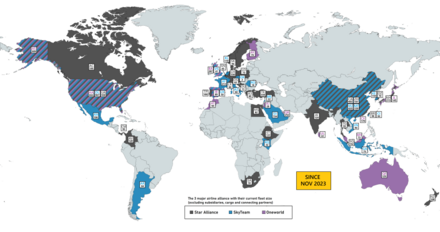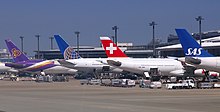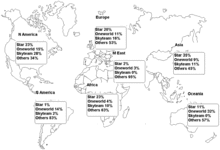avia.wikisort.org - Airline
An airline alliance is an aviation industry arrangement between two or more airlines agreeing to cooperate on a substantial level. Alliances may provide marketing branding to facilitate travelers making inter-airline codeshare connections within countries. This branding may involve unified aircraft liveries of member aircraft.[1]

In 2015, Star Alliance was the largest with 23% of total scheduled traffic in Revenue passenger kilometres (RPKs)/revenue passenger miles (RPMs), followed by SkyTeam with 20.4% and Oneworld with 17.8%, leaving 38.8% for others.[2] In 2019, by number of passengers, Star Alliance was leading 762 million,[3] followed by SkyTeam (630 million)[4] and Oneworld (535 million).[5]
Rationale
Benefits can consist of an extended network, often realised through codeshare agreements. Many alliances started as only codeshare networks. Cost reductions come from sharing operation facilities (e.g. catering or computer systems), operation staff (e.g. ground handling personnel, at check-in and boarding desks), investments and purchases (e.g. in order to negotiate extra volume discounts).[6] Traveller benefits can include lower prices due to lowered operational costs for a given route, different times to choose from, more destinations within easy reach, shorter travel times, more options of airport lounges shared with alliance members, fast track access on all alliance members if having frequent flyer status, faster mileage rewards by earning miles for a single account on several different carriers, round-the-world tickets, enabling travellers to fly over the world for a relatively low price.[7][8]
Airline alliances may also create disadvantages for the traveller, such as higher prices when competition is erased on a certain route or less frequent flights; for instance, if two airlines separately fly three and two times a day respectively on a shared route, their alliance might fly less than 5 (3+2) times a day on the same route. This might be especially true between hub cities for each airline. e.g., flights between Detroit Metropolitan Wayne County Airport (a Delta Air Lines fortress hub) and Amsterdam Airport Schiphol (a KLM fortress hub).[9][10][11]
History
The first airline alliance was formed in the 1930s, when Panair do Brasil and its parent company Pan American World Airways agreed to exchange routes to Latin America. In 1990, the African Joint Air Services (AJAS) Accord between Tanzania, Uganda and Zambia led to the launch of Alliance Air in 1994, with South African Airways, Air Tanzania, Uganda Airlines and the governments of Uganda and Tanzania as shareholders.[citation needed]
The first large alliance began in 1989, when Northwest Airlines and KLM agreed to large-scale codesharing. In 1992, the Netherlands signed the first open skies agreement with the United States, in spite of objections from the European Union, which gave both countries unrestricted landing rights on the other's soil. Normally landing rights are granted for a fixed number of flights per week to a fixed destination. Each adjustment requires negotiations, often between governments rather than between the companies involved. In return, the United States granted antitrust immunity to the alliance between Northwest Airlines and KLM. Other alliances would struggle for years to overcome the transnational barriers and lack of antitrust immunity, and still do so.[citation needed]
Star Alliance was founded in 1997,[12] which brought competing airlines to form Oneworld in 1999 and SkyTeam in 2000.[citation needed]
In 2007 Tai Tung Alliance was founded. There are three airlines, Korean based City Express, Japan based Super Flyer and Spain based Vacation Line.
In 2010 Richard Branson, chairman of the Virgin Group, announced his intention to form a fourth alliance among Virgin branded airlines (Virgin Atlantic; Virgin America; and the Virgin Australia Holdings group of airlines).[13] Then in September 2011, Branson said that Virgin Atlantic would join one of the existing alliances;[14] this idea was repeated in October 2012.[15] In December 2012, Delta Air Lines purchased Singapore Airlines' 49% stake in Virgin Atlantic for £224 million.[citation needed] Virgin America was absorbed into Alaska Airlines, which joined the Oneworld alliance in 2021.[16][17]
On February 14, 2013, it was announced that American Airlines and US Airways would merge, retaining the American Airlines name and would remain in the Oneworld alliance. US Airways' participation in Star Alliance lapsed. In 2012, in South America, LAN Airlines and TAM Airlines began their merger. In March 2014, with the merger complete, TAM left Star Alliance and became part of LAN in Oneworld.[citation needed]
On September 21, 2015, the Vanilla Alliance was formed between several airlines based in the Indian Ocean region, in order to improve air connectivity within the region. The founding members are Air Austral, Air Mauritius, Air Madagascar, Air Seychelles, and Int'Air Îles.[citation needed]
On January 18, 2016, the first alliance of low-cost carriers was formed, U-FLY Alliance. The founding members—HK Express, Lucky Air, Urumqi Air, and West Air—are all affiliated with HNA Group, although the alliance is also seeking airlines not within the group.[18]
On May 16, 2016, the world's largest alliance of low-cost carriers was formed, Value Alliance. The founding members were Cebu Pacific, Cebgo, Jeju Air, Nok Air, NokScoot, Scoot Airlines, Tigerair, Tigerair Australia, and Vanilla Air.[19]
Current alliances
Star Alliance


Star Alliance, founded in 1997, currently has 26 members:[20]
![]() Aegean Airlines, 2010
Aegean Airlines, 2010
![]() Air Canada, founder
Air Canada, founder
![]() Air China, 2007
Air China, 2007
![]() Air India, 2014
Air India, 2014
![]() Air New Zealand, 1999
Air New Zealand, 1999
![]() All Nippon Airways, 1999
All Nippon Airways, 1999
![]() Asiana Airlines, 2003
Asiana Airlines, 2003
![]() Austrian Airlines, 2000
Austrian Airlines, 2000
![]() Avianca, 2012
Avianca, 2012
![]() Brussels Airlines, 2009
Brussels Airlines, 2009
![]() Copa Airlines, 2012
Copa Airlines, 2012
![]() Croatia Airlines, 2004
Croatia Airlines, 2004
![]() EgyptAir, 2008
EgyptAir, 2008
![]() Ethiopian Airlines, 2011
Ethiopian Airlines, 2011
![]() EVA Air, 2013
EVA Air, 2013
![]() LOT Polish Airlines, 2003
LOT Polish Airlines, 2003
![]() Lufthansa, founder
Lufthansa, founder
![]()
![]()
![]() Scandinavian Airlines, founder
Scandinavian Airlines, founder
![]() Shenzhen Airlines, 2012
Shenzhen Airlines, 2012
![]() Singapore Airlines, 2000
Singapore Airlines, 2000
![]() South African Airways, 2006
South African Airways, 2006
![]() Swiss International Air Lines, 2006
Swiss International Air Lines, 2006
![]() TAP Air Portugal, 2005
TAP Air Portugal, 2005
![]() Thai Airways International, founder
Thai Airways International, founder
![]() Turkish Airlines, 2008
Turkish Airlines, 2008
![]() United Airlines, founder
United Airlines, founder
Former members:
 Adria Airways, 2004-2019, defunct
Adria Airways, 2004-2019, defunct Ansett Australia, 1999–2001, defunct
Ansett Australia, 1999–2001, defunct Blue1, 2004–2012, now a member affiliate
Blue1, 2004–2012, now a member affiliate BMI, 2000–2012, absorbed into British Airways[21]
BMI, 2000–2012, absorbed into British Airways[21] Continental Airlines, 2009–2012, merged with United Airlines
Continental Airlines, 2009–2012, merged with United Airlines Mexicana de Aviación, 2000–2004, joined Oneworld in 2009
Mexicana de Aviación, 2000–2004, joined Oneworld in 2009 Shanghai Airlines, 2007–2010, merged with China Eastern Airlines and joined SkyTeam in 2011
Shanghai Airlines, 2007–2010, merged with China Eastern Airlines and joined SkyTeam in 2011 Spanair, 2003–2012, defunct
Spanair, 2003–2012, defunct TACA, 2012–2013, merged with Avianca
TACA, 2012–2013, merged with Avianca Avianca Brazil, 2015–2019, defunct
Avianca Brazil, 2015–2019, defunct TAM Airlines, 2010–2014, merged with LAN Airlines and joined Oneworld in 2014
TAM Airlines, 2010–2014, merged with LAN Airlines and joined Oneworld in 2014 US Airways, 2004–2014, joined Oneworld as an affiliate member of American Airlines
US Airways, 2004–2014, joined Oneworld as an affiliate member of American Airlines Varig, 1997–2007, defunct
Varig, 1997–2007, defunct
Star Alliance Connecting Partners
 Juneyao Airlines, 2017
Juneyao Airlines, 2017 Thai Smile, 2020
Thai Smile, 2020
Oneworld

Oneworld, founded in 1999, currently has 13 members:[22]
![]() Alaska Airlines, 2021
Alaska Airlines, 2021
![]() American Airlines, founder
American Airlines, founder
![]() British Airways, founder
British Airways, founder
![]() Cathay Pacific, founder
Cathay Pacific, founder
![]() Finnair, 1999
Finnair, 1999
![]() Iberia Airlines, 1999
Iberia Airlines, 1999
![]() Japan Airlines, 2007
Japan Airlines, 2007
![]() Malaysia Airlines, 2013
Malaysia Airlines, 2013
![]() Qantas, founder
Qantas, founder
![]() Qatar Airways, 2013
Qatar Airways, 2013
![]() Royal Air Maroc, 2020
Royal Air Maroc, 2020
![]() Royal Jordanian, 2007
Royal Jordanian, 2007
![]() SriLankan Airlines, 2014
SriLankan Airlines, 2014
Former members:
 Air Berlin, 2010–2017, defunct
Air Berlin, 2010–2017, defunct Canadian Airlines, founder, 1999–2000, acquired by Air Canada
Canadian Airlines, founder, 1999–2000, acquired by Air Canada LATAM Brasil, 2014–2020
LATAM Brasil, 2014–2020 LATAM Chile, 2000–2020
LATAM Chile, 2000–2020 Malév Hungarian Airlines, 2007–2012, defunct
Malév Hungarian Airlines, 2007–2012, defunct Mexicana de Aviación, 2009 (ceased operations in 2010)
Mexicana de Aviación, 2009 (ceased operations in 2010) S7 Airlines, 2010–2022, suspended from alliance
S7 Airlines, 2010–2022, suspended from alliance US Airways, 2014–2015, merged with American Airlines
US Airways, 2014–2015, merged with American Airlines
Future member:
 Oman Air, joining in 2024
Oman Air, joining in 2024
Oneworld Connect Partners
 Fiji Airways, 2018
Fiji Airways, 2018
Oneworld Transatlantic Joint Venture members
SkyTeam

SkyTeam, founded in 2000, currently has 18 members:[23]
![]() Aerolíneas Argentinas, 2012
Aerolíneas Argentinas, 2012
![]() Aeroméxico, founder
Aeroméxico, founder
![]() Air Europa, 2007
Air Europa, 2007
![]() Air France, founder
Air France, founder
![]() China Airlines, 2011
China Airlines, 2011
![]() China Eastern Airlines, 2011
China Eastern Airlines, 2011
![]() Czech Airlines, 2001
Czech Airlines, 2001
![]() Delta Air Lines, founder
Delta Air Lines, founder
![]() Garuda Indonesia, 2014
Garuda Indonesia, 2014
![]() ITA Airways, 2021
ITA Airways, 2021
![]() Kenya Airways, 2007
Kenya Airways, 2007
![]() KLM Royal Dutch Airlines, 2004
KLM Royal Dutch Airlines, 2004
![]() Korean Air, founder
Korean Air, founder
![]() Middle East Airlines, 2012
Middle East Airlines, 2012
![]() Saudia, 2012
Saudia, 2012
![]() TAROM, 2010
TAROM, 2010
![]() Vietnam Airlines, 2010
Vietnam Airlines, 2010
![]() XiamenAir, 2012
XiamenAir, 2012
Former members:
 Aeroflot, 2006–2022, suspended from alliance
Aeroflot, 2006–2022, suspended from alliance Alitalia, 2001–2021, defunct
Alitalia, 2001–2021, defunct China Southern Airlines, 2007–2018
China Southern Airlines, 2007–2018 Continental Airlines, 2004–2009, joined Star Alliance in 2009
Continental Airlines, 2004–2009, joined Star Alliance in 2009 Copa Airlines, 2007–2009, joined Star Alliance in 2012
Copa Airlines, 2007–2009, joined Star Alliance in 2012 Northwest Airlines, 2004–2010, merged with Delta Air Lines
Northwest Airlines, 2004–2010, merged with Delta Air Lines
Future members:
 Virgin Atlantic, joining in 2023
Virgin Atlantic, joining in 2023
Vanilla Alliance
Vanilla Alliance, founded in 2015, currently has 5 members:[24]
![]() Air Austral, founder
Air Austral, founder
![]() Air Madagascar, founder
Air Madagascar, founder
![]() Air Mauritius, founder
Air Mauritius, founder
![]() Air Seychelles, founder
Air Seychelles, founder
![]() Int'Air Îles, founder
Int'Air Îles, founder
U-FLY Alliance
U-FLY Alliance, founded in 2016, currently has 5 members:[25]
![]() Eastar Jet, 2016
Eastar Jet, 2016
![]() HK Express, founder
HK Express, founder
![]() Lucky Air, founder
Lucky Air, founder
![]() Urumqi Air, founder
Urumqi Air, founder
![]() West Air, founder
West Air, founder
Value Alliance
Value Alliance, founded in 2016, currently has 5 members:[26]
![]() Cebu Pacific, founder
Cebu Pacific, founder
![]() Cebgo, founder
Cebgo, founder
![]() Jeju Air, founder
Jeju Air, founder
![]() Nok Air, founder
Nok Air, founder
![]() Scoot, founder
Scoot, founder
Former members:
 NokScoot, 2016–2020, defunct
NokScoot, 2016–2020, defunct Tigerair, 2016–2017, merged with Scoot
Tigerair, 2016–2017, merged with Scoot Tigerair Australia, 2016–2018, founder
Tigerair Australia, 2016–2018, founder Vanilla Air, 2016–2018, founder, merged with Peach Aviation
Vanilla Air, 2016–2018, founder, merged with Peach Aviation
Statistics
| Alliance | Members | Passengers /year |
Countries served |
Destination | Fleet | Employees | Revenue /year (US$) |
Flights /day |
RPK[2] | |
|---|---|---|---|---|---|---|---|---|---|---|
| Star Alliance[27] | 26 | 642.1 Mn | 195 | 1,360 | 5,000 | 432,603 | 179.05 Bn | 19,000 | 1536 Bn | 23% |
| SkyTeam[28] | 19 | 665.4 Mn | 175 | 1,062 | 3,937 | 481,691[29] | 140.98 Bn[29] | 17,343 | 1362 Bn | 20.4% |
| Oneworld[30] | 14 | 557.4 Mn | 161 | 1,016 | 3,560 | 382,913 | 130.92 Bn | 13,814 | 1189 Bn | 17.8% |
| Value Alliance[31] | 7 | 180 Mn | 30 | 183 | 554 | - | - | 400 | 107 Bn | 1.6% |
| U-FLY Alliance | 8 | 200 Mn | 18 | 149 | 593 | - | - | 420 | 40 Bn | 0.6% |
| Vanilla Alliance | 5 | 2.3 Mn | 26 | 89 | 46 | - | - | - | - | |

Notes and references
- Fernandez de la Torre, Pablo E. (1999). "Airline alliances : the airline perspective". DSpace@MIT. hdl:1721.1/68159. Retrieved April 15, 2014.
- "Scheduled Passengers Carried". World Air Transport Statistics 60th Edition. IATA.
- "backgrounder". Star Alliance. 18 Oct 2019.
- "Fact Sheet" (PDF). SkyTeam. 2019.
- "20 years, 20 facts, oneworld". OneWorld. 2019-02-01. Archived from the original on 2019-11-30. Retrieved 2019-12-22.
- Crail, Chauncey (2021-02-10). "What Is An Airline Alliance?". Forbes Advisor. Retrieved 2022-02-07.
- "Why Do Airlines Join Alliances? What Are The Benefits?". Simple Flying. 2019-11-03. Retrieved 2022-02-07.
- Gaggero, Alberto A.; Bartolini, David (2012). "The Determinants of Airline Alliances". Journal of Transport Economics and Policy. 46 (3): 399–414. ISSN 0022-5258.
- Flores-Fillol, Ricardo; Moner-Colonques, Rafael (2007). "Strategic Formation of Airline Alliances". Journal of Transport Economics and Policy. 41 (3): 427–449. ISSN 0022-5258.
- Armantier, Olivier; Richard, Oliver (2008). "Domestic Airline Alliances and Consumer Welfare". The RAND Journal of Economics. 39 (3): 875–904. ISSN 0741-6261.
- "Airline Alliance's Benefits and Drawbacks Explained". www.aerotime.aero. Retrieved 2022-02-07.
- BRYANT, ADAM (14 May 1997). "United and 4 Others to Detail Air Alliance Today". The New York Times. Archived from the original on 30 January 2013. Retrieved 16 October 2010.
- Perman, Stacy (2010-09-05). "Virgin's Richard Branson Circles His Wagons". Time. Archived from the original on 2 November 2010. Retrieved 2011-03-04.
- Bruner, Jon (2011-09-14). "Virgin Atlantic Will Join an Alliance Soon, Says Richard Branson". Forbes.
- Quinn, James (2012-10-26). "Virgin Atlantic to join global airline alliance, says Branson". Telegraph. Archived from the original on 2013-05-05.
- "Virgin America flights become Alaska next April". Flightglobal.com. 2017-10-05. Retrieved January 2, 2018.
- "Alaska Airlines Officially Joins oneworld". 2021-03-31. Retrieved July 5, 2021.
- "HNA Group: four airlines form U-FLY Alliance, world's first LCC grouping, showing HNA consolidation". CAPA - Centre for Aviation. 22 January 2016. Retrieved 11 February 2016.
- "Singapore Airlines’ Low-Cost Carriers, Others Start Alliance". Bloomberg. 16 May 2016. Retrieved 16 May 2016.
- "Member airline". Star Alliance. June 2013. Archived from the original on 2013-03-04.
- "Bmi Formally Leaves". Star Alliance. 2012-05-31. Archived from the original on 2012-10-16. Retrieved 2012-10-15.
- "Member Airlines". Oneworld.
- "Facts and Figures". SkyTeam. 5 March 2014.
- "Vanilla Alliance agreements signed in Antananarivo". ch-aviation. Retrieved 2016-04-09.
- "UFLY Alliance". www.uflyalliance.com. Archived from the original on August 25, 2018. Retrieved April 9, 2016.
- "Value Alliance". www.valuealliance.com/. Retrieved 2016-05-16.
- "Facts and Figures". Star Alliance. 2 July 2015.
- "Factsheet" (PDF). SkyTeam. Summer 2016.
- "Factsheet" (PDF). SkyTeam. March 2015. Archived from the original on 2015-05-30.
{{cite web}}: CS1 maint: bot: original URL status unknown (link) - "oneworld at a glance". Oneworld. July 2016.
- "About". Value Alliance.
External links
- Oneworld
- SkyTeam
- Star Alliance
- Value Alliance
- Graham Dunn (15 May 2017). "The 20-year history of global airline alliances". Flightglobal.
На других языках
[de] Luftfahrtallianz
Eine Luftfahrtallianz ist eine strategische Kooperation von mehreren Luftfahrtunternehmen (Fluggesellschaften). Dabei bleiben die Unternehmen rechtlich eigenständig.- [en] Airline alliance
[fr] Alliance de compagnies aériennes
Les alliances entre compagnies aériennes sont des accords de coopération entre compagnies aériennes.Другой контент может иметь иную лицензию. Перед использованием материалов сайта WikiSort.org внимательно изучите правила лицензирования конкретных элементов наполнения сайта.
WikiSort.org - проект по пересортировке и дополнению контента Википедии